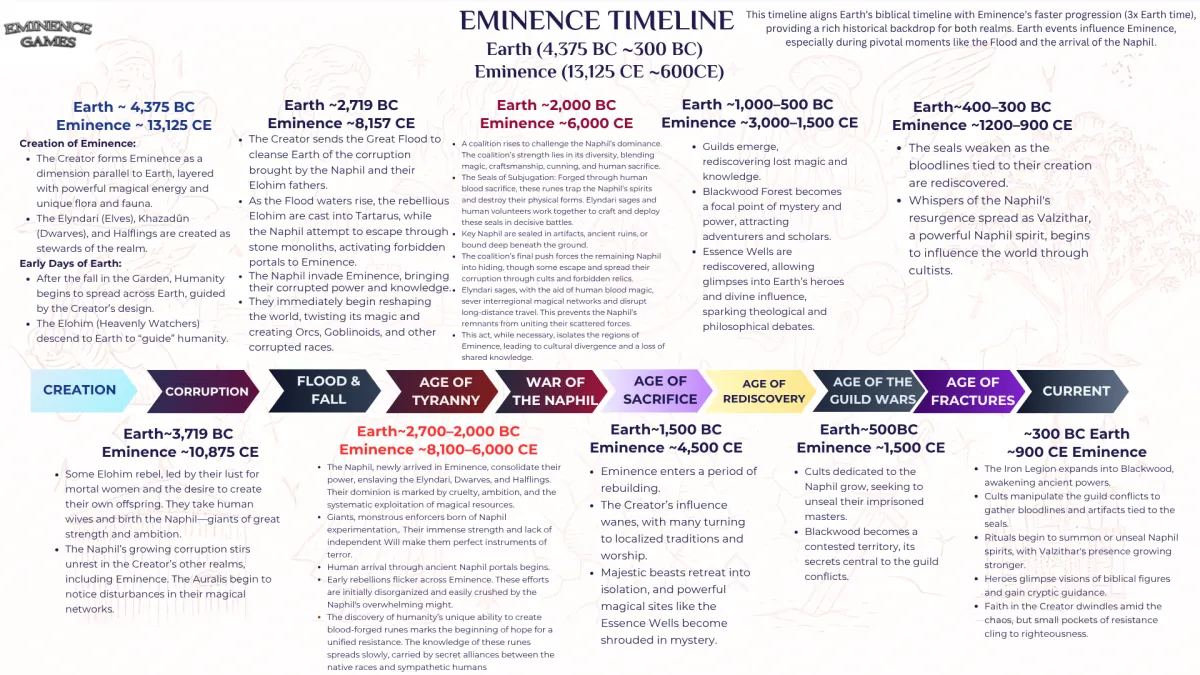
The World of Eminence: A Realm in Turmoil
Creation: Earth ~4,375 BC | Eminence ~13,125 CE
In the Beginning
“In the beginning God created the heavens and the earth.”
—Genesis 1:1
But the heavens are not one realm, and the story not confined to Earth. At the dawn of all things, the Creator spoke, and from His Word came not just one world, but many—woven with purpose, each fulfilling a part of His greater design. Time, light, and matter sprang forth in divine harmony. Earth was formed for humanity, its soil rich with trial and hope. The stars were hung, the seas contained, and angels—Elohim—were sent to guide creation with wisdom and reverence.
But alongside Earth, He formed Eminence—a realm not fallen, not mundane. A place outside the natural rhythms of Earth, set apart yet aligned. Eminence did not follow the slow arc of entropy, but moved at the pace of purpose. Its skies shimmered with unseen constellations. Its waters carried memory. Its stones held breath. This was no afterthought—it was a realm of preparation, mystery, and wonder. A divine echo, hidden across the veil.
In Heaven, the hosts worshiped. On Earth, mankind would be tested. But Eminence… Eminence was sanctified ground, awaiting its stewards.
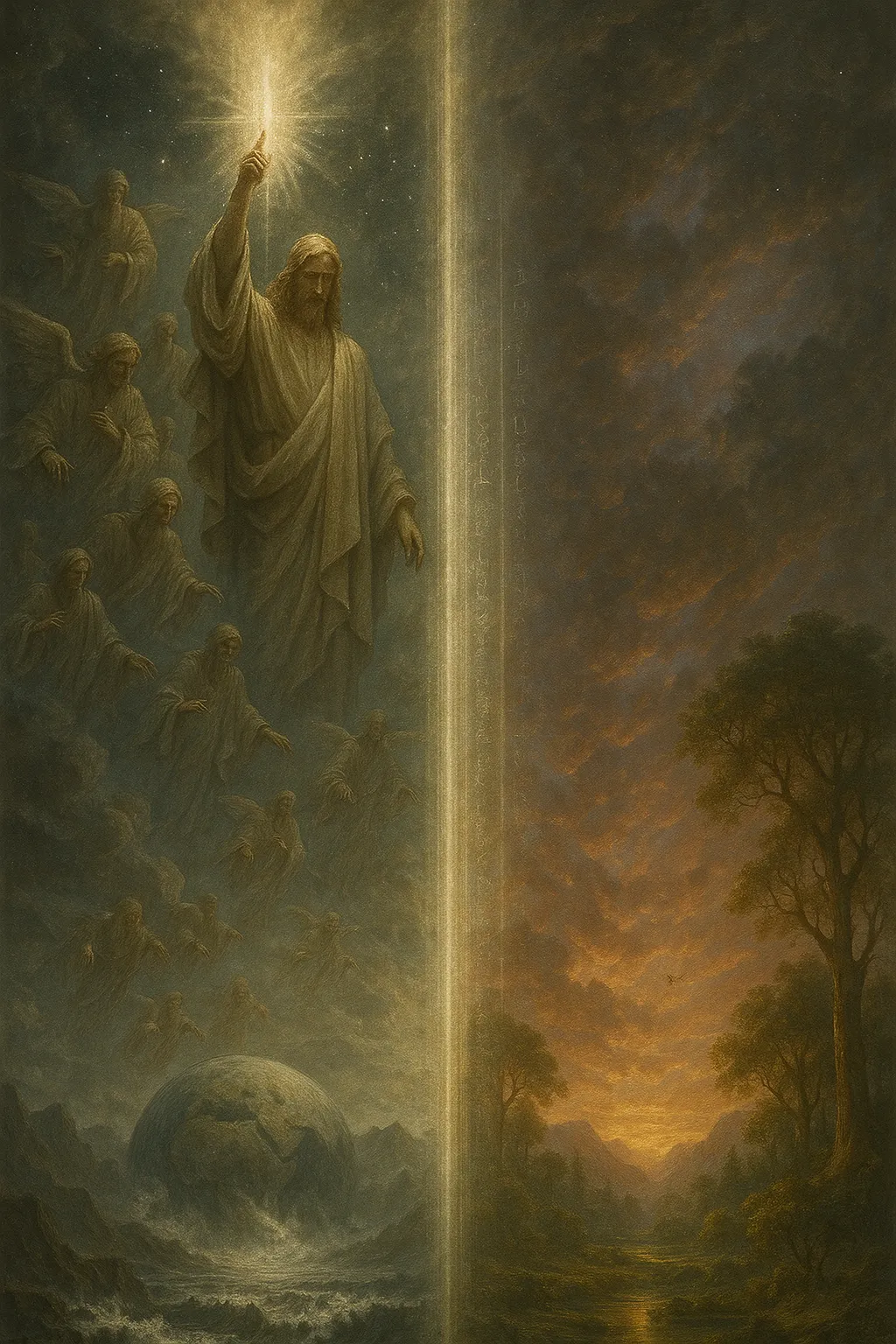
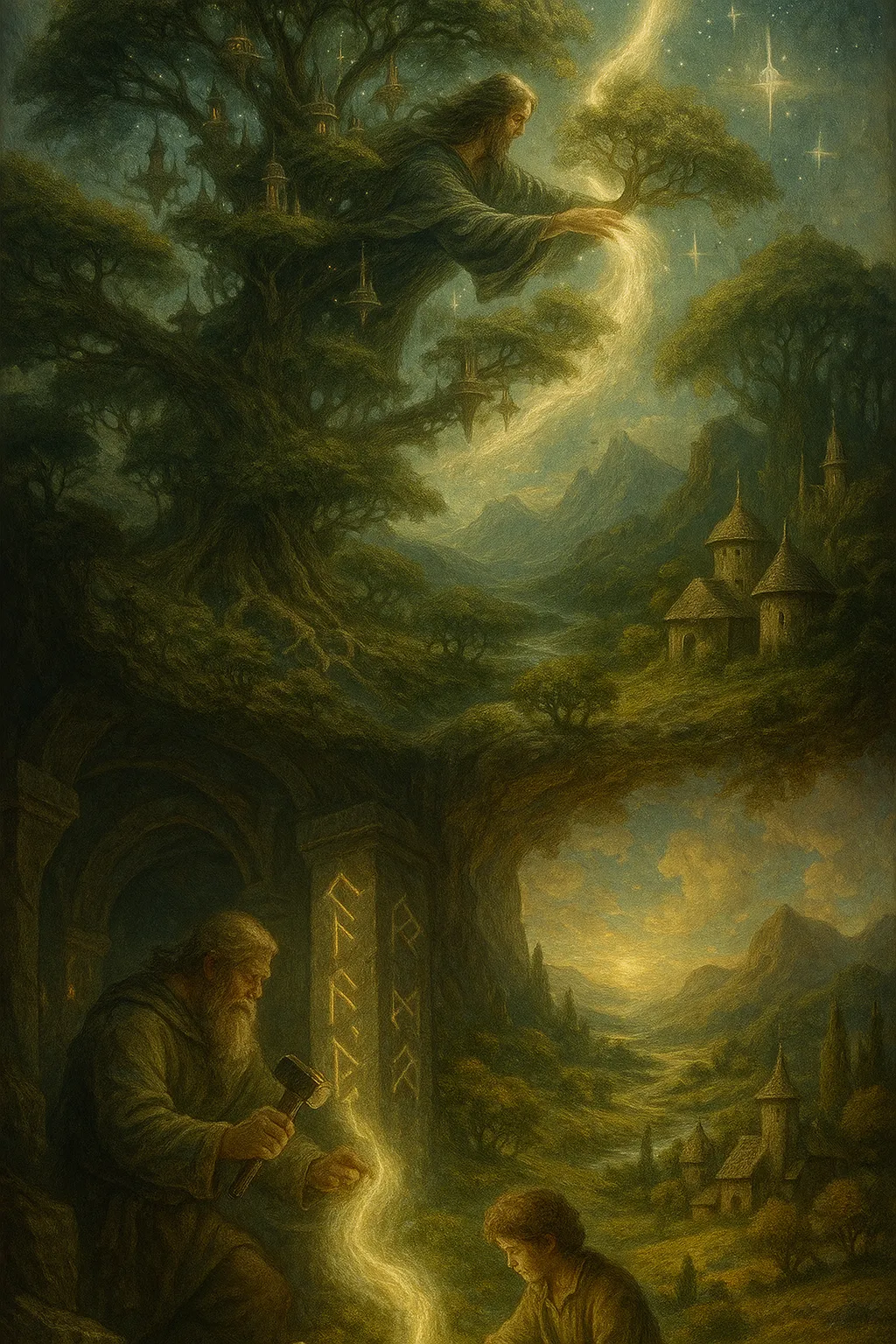
The Shaping of Eminence
Before corruption, before the veil was torn, Eminence stood as a world of divine craftsmanship— a parallel creation , layered with raw magic and sacred order. Formed not from dust, but from intention, it bore the hallmarks of celestial design. The Creator did not populate this realm with humanity, but with three ancient peoples, each embodying an aspect of divine stewardship. The Elyndari, beings of grace and long memory, were tied to wind and forest. They spoke the language of stars, tended living groves, and kept the knowledge of the First Light. The Khazadûn , strong and enduring, emerged from the deep earth. Fire was their ally, stone their scripture. They built with precision and preserved the sacred art of runesmithing. And the Halflings
, joyful and clever, filled the hills and valleys, tilling the land and cultivating a life of balance—content with enough, yet vigilant against excess.
These three races lived not in isolation but in harmony, shaping the lands of Eminence with reverence. Magic was not studied—it was breathed, sung, and lived. Their cities echoed with song and silence, invention and instinct. In that age, the world did not war with itself. Every creature and current knew its place in the Creator’s design.
But such harmony cannot last—not when the fall of one realm casts a shadow over the other.
Corruption: Earth ~3,719 BC | Eminence ~10,875 CE
The Fall of the Watchers
“The sons of God came in to the daughters of men, and they bore children to them... giants were on the earth in those days.
—Genesis 6:4
They were called Elohim, holy ones, appointed as watchers over mankind. Sent not to rule, but to guide—creatures of flame and purpose, radiant in form, bearing the knowledge of heaven. But as they descended and walked among mortals, their wonder gave way to desire. Drawn to the beauty of humankind, they cast aside their duty and took wives among the daughters of men.
From these forbidden unions came the Naphil—giants of immense size and terrifying potential. Blessed with the power of heaven but born outside the Creator’s will, they grew not in humility, but in hunger. They devoured, dominated, and reshaped the world in their image. Kingdoms rose and fell at their whim. The knowledge of their fathers—secrets of the stars, of metal, of war—was taught to mortals, and blood was shed in new ways.
As the Naphil’s might spread, so too did their pride. They called themselves gods and demanded worship. The earth groaned beneath them, and the heavens mourned. What began as guidance became rebellion, and the world, once shepherded by divine light, plunged into shadow. The Creator, long patient, now looked upon His broken creation with sorrow—and prepared judgment.
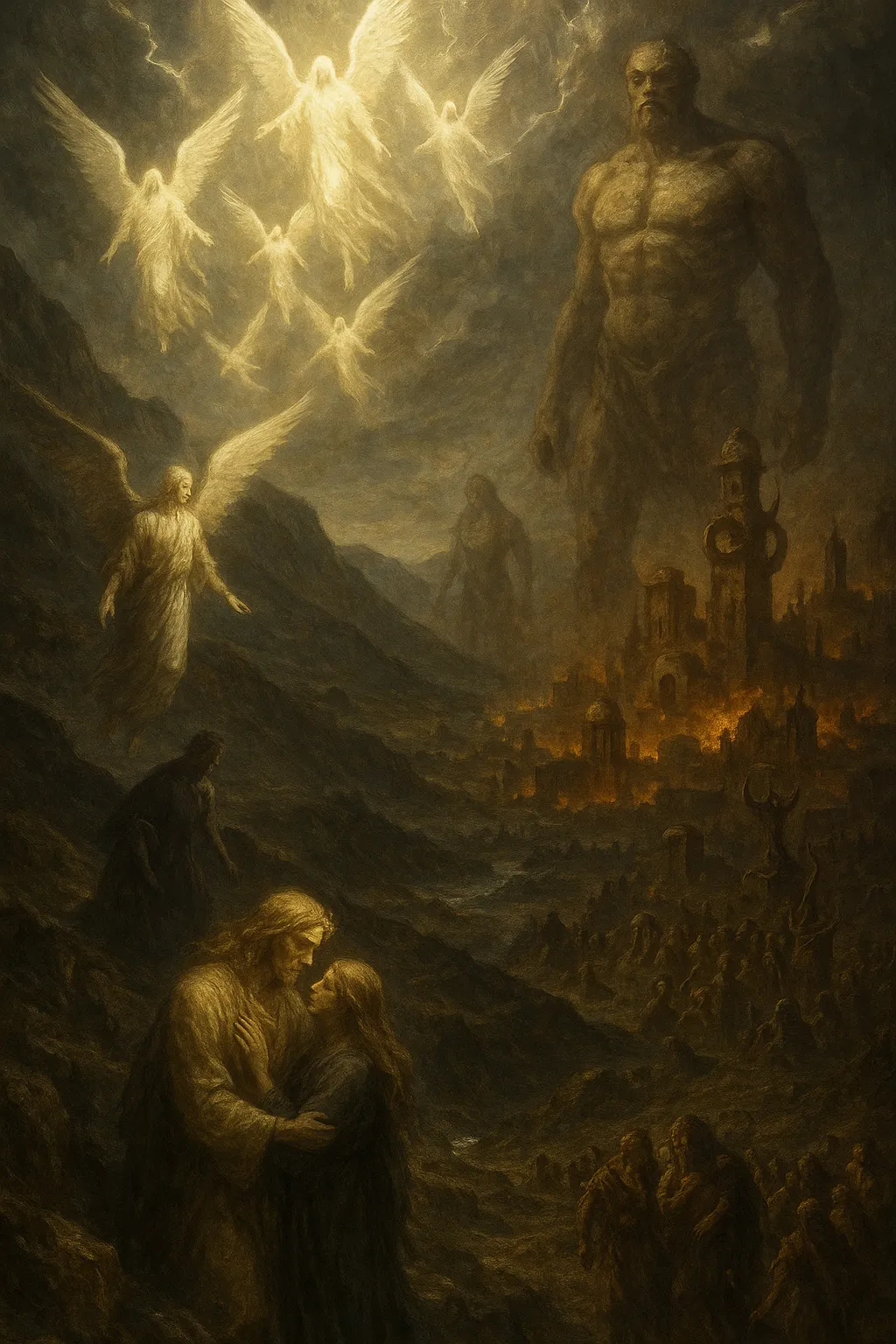
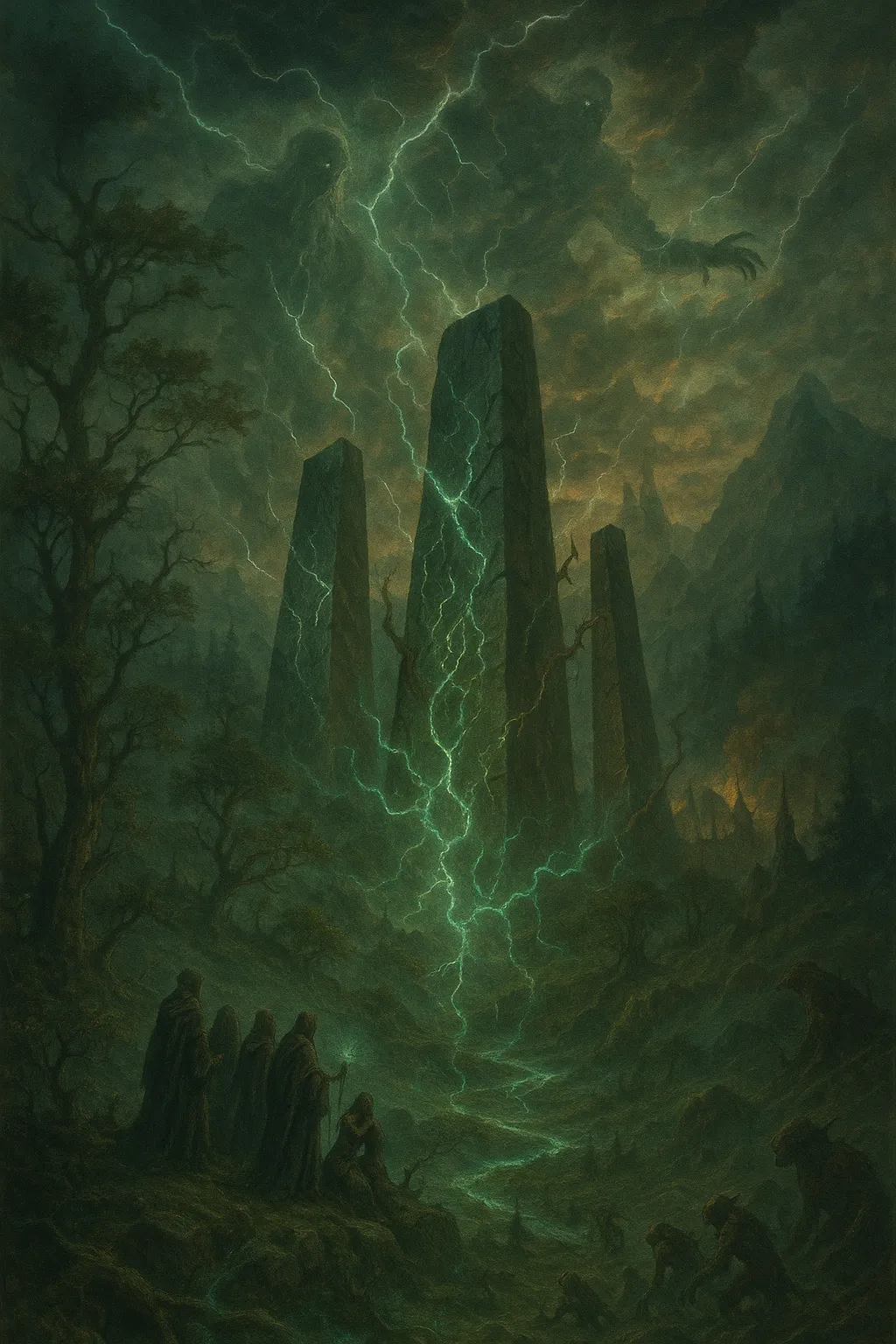
Disturbance in the Veil
Eminence had long stood untouched by Earth’s unraveling. Though formed as a parallel realm, it was sanctified—separate, sacred, and sealed. But even sealed doors tremble when thunder knocks. As the rebellion of the Elohim stirred chaos on Earth,
the veil between realms grew thin, and the currents of magic in Eminence began to warp.
The Auralis, angelic beings who guarded the balance of Eminence, were the first to sense it. Their songs, once in tune with the Creator’s rhythm, fell out of harmony. The stars shifted. Ancient beasts stirred in their sleep. In hidden groves, Elyndari seers prophesied of a “Wound in the World.” But the nature of the threat remained veiled… until the Naphil themselves began reaching across.
Empowered by their heavenly blood, the Naphil sought to flee the coming Flood. Their minds and bodies were not bound by one realm alone. In ancient stone they found the key— monoliths hidden on Earth that hummed with cross-dimensional power. Forbidden rituals awakened the portals. Though not yet open, they pulsed with potential, and through them flowed whispers of ruin.
The balance in Eminence faltered. Magic twisted. Strange mutations bloomed in the wild. Creatures once noble turned feral. Orcs and Goblinoids first appeared—not born, but reshaped, as if Eminence itself was reacting to the Naphil's spiritual weight before their bodies had even arrived.
The corruption had begun—not through armies or conquest, but through a fracture in reality itself.
Flood & Fall: Earth ~2,719 BC | Eminence ~8,157 CE
The Waters of Judgment
“And God saw that the wickedness of man was great in the earth... and it grieved Him to His heart.”
—Genesis 6:5–6
The earth had become a place of ruin. The Naphil ruled with violence, the fallen worshiped shadows, and the Elohim who remained faithful wept for their fallen kin. The heavens, once patient, began to stir with wrath. The Creator, long-suffering and righteous, decreed an end—not to man, but to corruption.
So came the Flood, not merely a rising of waters, but a divine act of cleansing. Rain fell, but so did the sky. The firmament above was broken; the fountains of the deep burst forth. Cities drowned. Giants fell. Mountains vanished beneath waves. All the works of the Naphil, all the altars to false gods, were swallowed. Only a remnant would survive: a vessel, a family, and the promise of renewal.
But not all were taken by the tide. The Naphil, desperate to escape judgment, turned their eyes to the veil—to
Eminence. Their fathers had shown them how to cross. Monoliths awakened. The sky split once more. And through those tears in reality, they fled, dragging the weight of their sin into another world.
Thus, as Earth was purified, Eminence was pierced—and its long fall began.
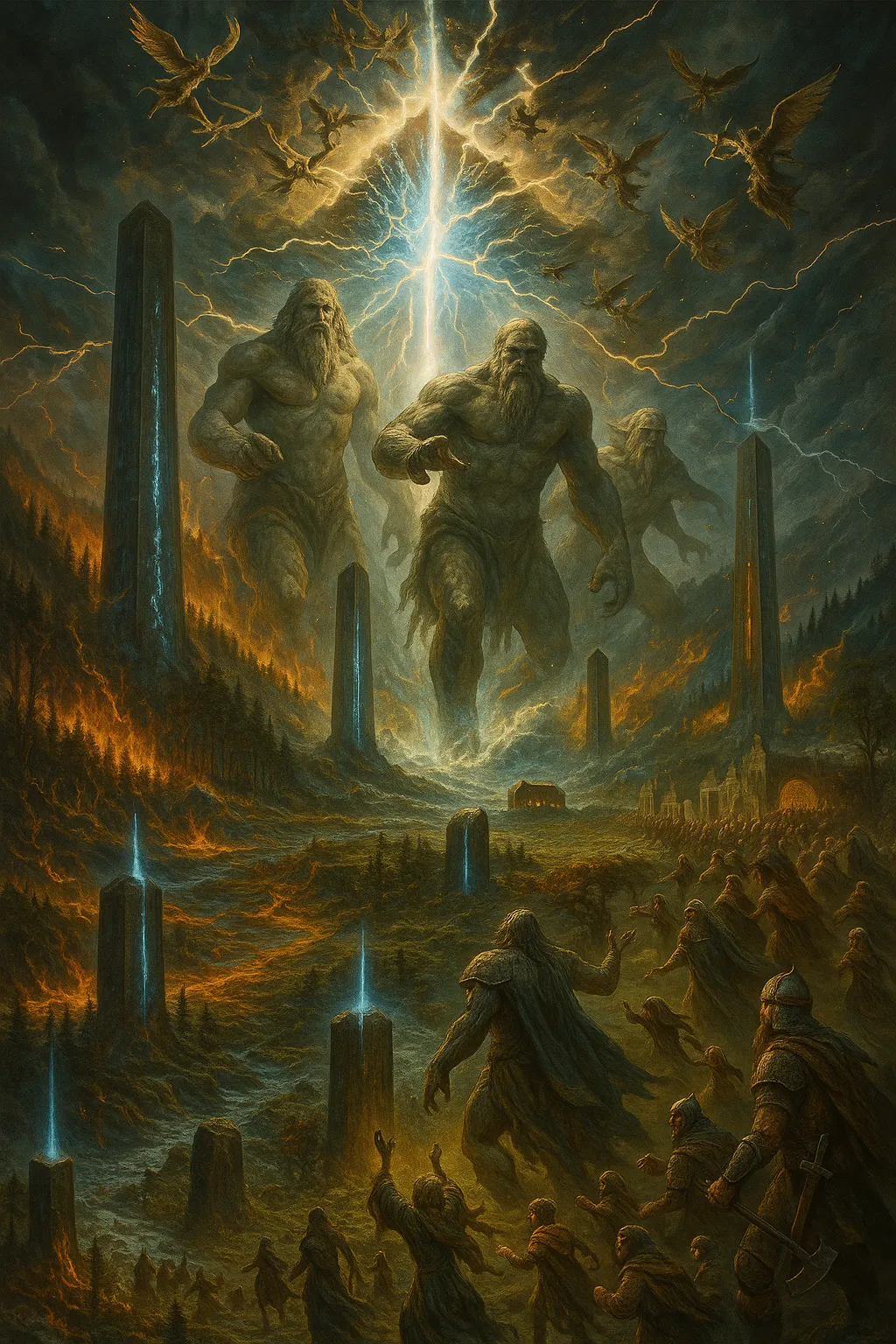
The Breaking of Eminence
The veil was never meant to be broken by force. When the
Naphil crossed into Eminence, they did not arrive as visitors, but as a cataclysm. The world shuddered. Magic recoiled. The sky warped with the strain of their presence. Though few in number, their power was overwhelming. They reshaped land with a word, corrupted forests with their breath, and desecrated ancient places with their very footsteps.
The Auralis, defenders of the balance, met them with fury and fire—but the clash of divine blood fractured the heavens. Entire regions of Eminence were sealed off, cursed, or twisted. And with the giants came others: humanity, castaways of a drowned world, stumbling into a realm of wonder and ruin. Some bore the faith of Noah, walking with reverence. Others clung to fear, pride, or greed.
The native peoples of Eminence—Elyndari, Khazadûn, and Halflings—were forced to adapt. Some sheltered the refugees. Others resisted them. But all saw the truth: the world had changed. The harmony of old was broken. The land itself groaned beneath the weight of new sin.
And yet, in the shadow of disaster, new bonds were forged. Bloodlines mingled. Cultures crossed. Prophecies stirred. For even in the deepest fall, the seed of redemption lay buried.
Age of Tyranny: Earth ~2,700 - 2000 BC | Eminence ~8100 - 6,000 CE
Thrones of Ruin
The Naphil had escaped judgment—but not justice. Their bodies had survived the Flood, but their souls were marked by defiance. And now, in Eminence, they found a land of wild beauty and divine resonance—a land they could twist.
They built great cities of stone and bone, raised monoliths that drained the land’s essence, and declared themselves gods to those beneath them. Their knowledge of the Elohim’s sacred arts allowed them to bind magic into cruel forms: flames that never died, winds that screamed, beasts bred only to serve. They enslaved native peoples, shattered ancient pacts, and hunted down the Auralis who had once stood as guardians.
The Elyndari retreated into the deepest woods and the highest spires. The Khazadûn sealed their gates and etched runes of protection across their vaults. The Halflings, once free and joyous, were scattered—some serving under cruel yokes, others vanishing into hidden hills.
To mankind, the Naphil offered power in exchange for loyalty. Kingdoms rose in their names. Shrines were built. Blood sacrifices became law. Those who opposed them were erased not just from the earth, but from memory. For centuries, Eminence bent beneath tyrant kings who were not kings at all—but broken sons of Heaven, drunk on stolen thrones
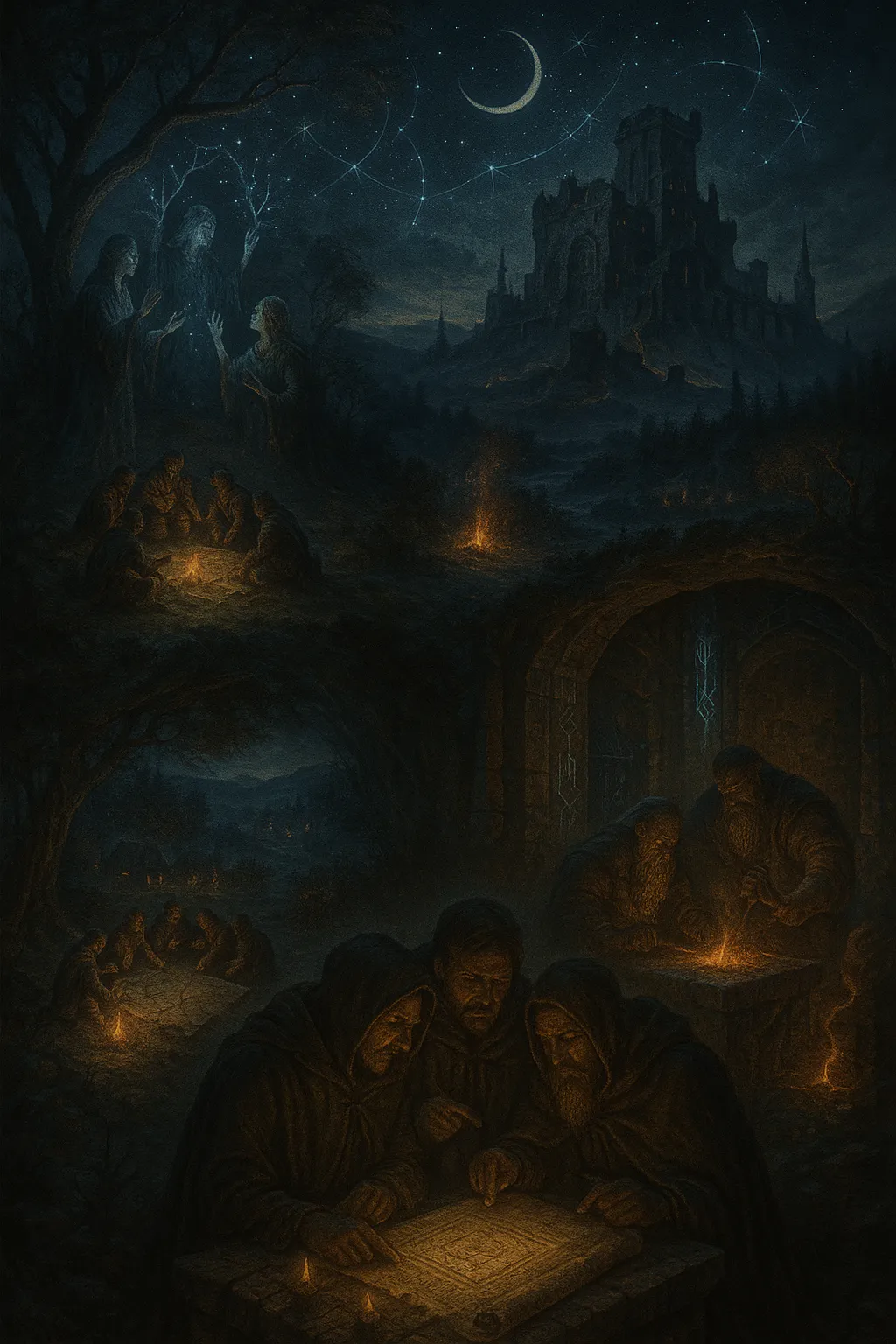
Embers of Defiance
But fire does not only consume—it also spreads. And in the dark silence beneath tyranny’s weight, sparks began to stir.
From hidden groves, Elyndari Waykeepers passed down forbidden songs—melodies that could unravel the spells of the Naphil. In the mountain deeps, the Khazadûn reforged old weapons, etching truth into steel. Among scattered Halfling bands, clever voices whispered of rebellion, of outwitting giants with guile instead of strength.
And among mankind, not all bowed. Some remembered the Creator. Some carried ancient scrolls, handed down from before the Flood. They did not forget the judgment that fell upon Earth—and began to see signs that the same would come to Eminence if the giants were not stopped.
Rebellion was not swift. It was quiet. Patient. Costly. But in time,
the oppressed became the coalition : Elves, Dwarves, Halflings, and the first humans—fighting together in a war of attrition. Spells once corrupted were reclaimed. Runes long buried were reawakened. For every tower toppled, a martyr fell. For every victory, another curse was broken.
In the end, the Naphil were cast down—not killed, for few could be slain—but sealed beneath the earth they had once ruled. Their cities collapsed, their thrones turned to dust.
But no seal is eternal. And even in silence, they whisper..
War of the Naphil: Earth ~2,000 BC | Eminence ~6,000 CE
The Breaking Point
For generations, Eminence endured beneath the rule of the Naphil—giants born of heaven’s rebellion and earth’s sin. They ruled not with armies, but with awe and terror, twisting magic, reshaping the land, and enslaving those who lived beneath their shadows. But even stone cracks when pressure builds. And eventually, the world broke. The Elyndari, once hidden among the stars and forests, emerged with ancient songs capable of unraveling divine enchantments. The Khazadûn, long silent in their deep halls, brought forth rune-bound weapons forged with purpose and prophecy. The Halflings, underestimated by giants, became the unseen hands of rebellion—messengers, saboteurs, and scouts. And humanity, fragmented yet fierce, found its voice in the fires of resistance.
The Naphil, vast in power, were not unchallenged—but they were arrogant. Their downfall began not with one battle, but with a movement—coordinated strikes, lost relics recovered, sealed magics reawakened. The first sanctums were not made to guard—they were made to trap
Eminence became a battleground. Skies burned. Rivers boiled. The Auralis descended once more, some sacrificing themselves in open war. In those days, the stars did not move , as if Heaven itself watched, holding its breath.
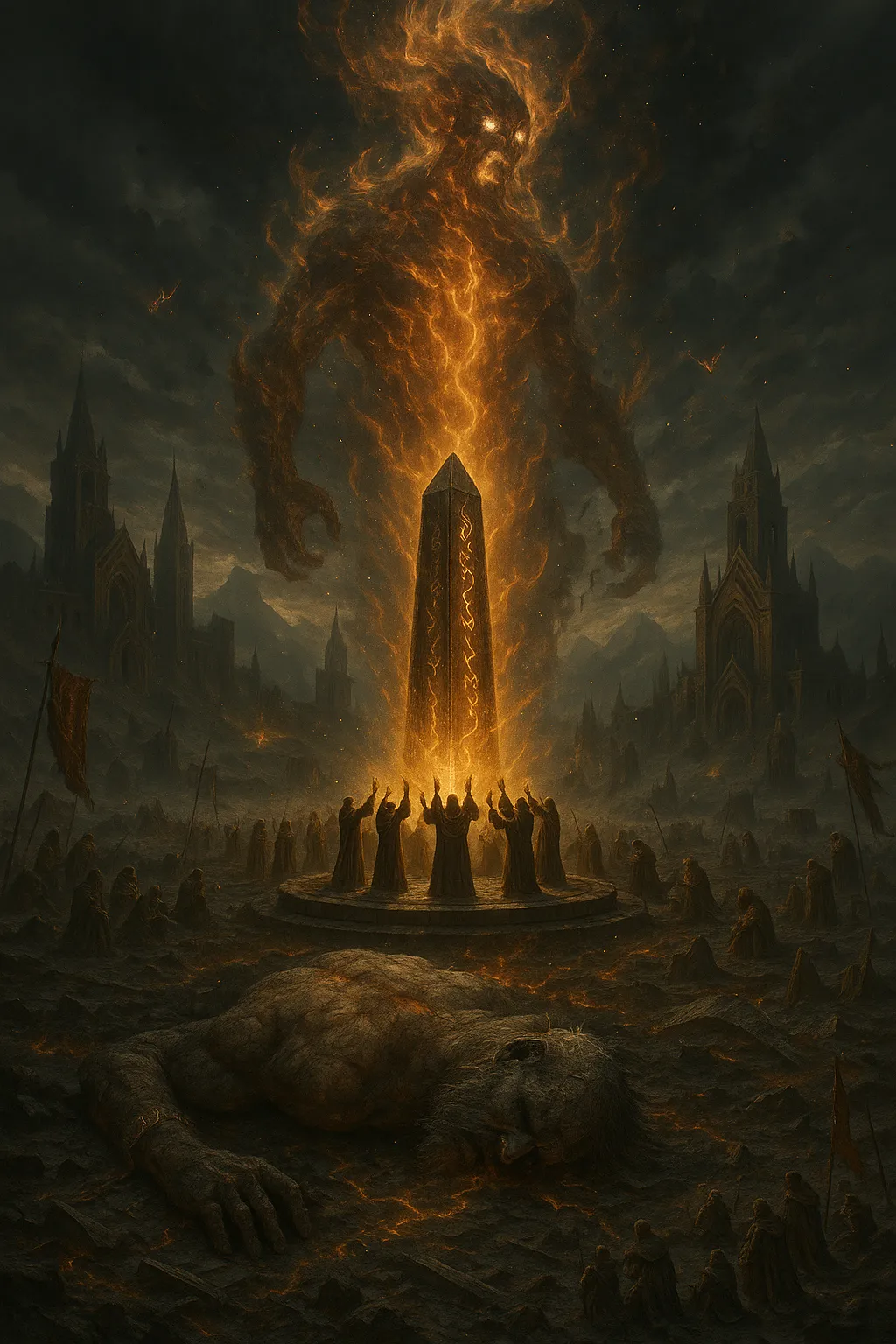
The Great Sealing
Victory came not through annihilation, but through
sacrifice.
The Naphil, too great to be killed outright, were instead
sealed—each buried beneath warded earth, entombed beneath runes written in blood, light, and law. At the sites of their fall,
Sanctums were raised, each guarded by chosen lineages who would give their lives to keep the bonds intact.
But the price was terrible.
Entire cities were consumed in the last battles. Magic itself became unstable—stretched to its limits by the binding rites. Whole regions were twisted by lingering divine residue. The Auralis, drained from open war, withdrew once more—fewer now, and forever changed.
And so, the War of the Naphil ended—but it left Eminence fractured. The victors did not march in triumph; they
collapsed in mourning. The world entered an age of silence, burdened by the knowledge that the enemy was not gone—only sleeping.
This war marked the end of an era. From its ashes rose the
Age of Sacrifice, where peace came not through power, but through pain.
Age of Sacrifice: Earth ~1,500 BC | Eminence ~4,500 CE
Ashes of Victory
The Naphil were sealed—but victory left no joy. Their fall came only through great cost. Entire regions of Eminence were ruined. Forests became haunted wastelands. Mountain ranges collapsed. Rivers ran backward with corrupted magic. And the peoples of the realm—Elyndari, Khazadûn, Halfling, and Human—were left scattered, exhausted, and changed.
The Auralis, celestial warriors who once walked among mortals, were broken. Many had given their light in the final battles. Others withdrew into silence, mourning the imbalance that still clung to the world. The veils between realms remained fragile, and the power that sealed the giants demanded vigilance—and blood.
This was an age of sacred duty. Heroes became guardians of the seals. Entire generations gave their lives to maintain the ancient bonds that held the Naphil beneath the earth. Cities were built not for comfort, but for defense. Runes were etched into stone, bone, and soul—symbols of binding, of warding, of remembrance. Magic was feared as much as it was revered.
Eminence had survived, but it no longer trusted peace. Even in prayer, there was watchfulness. Even in victory, there was grief.
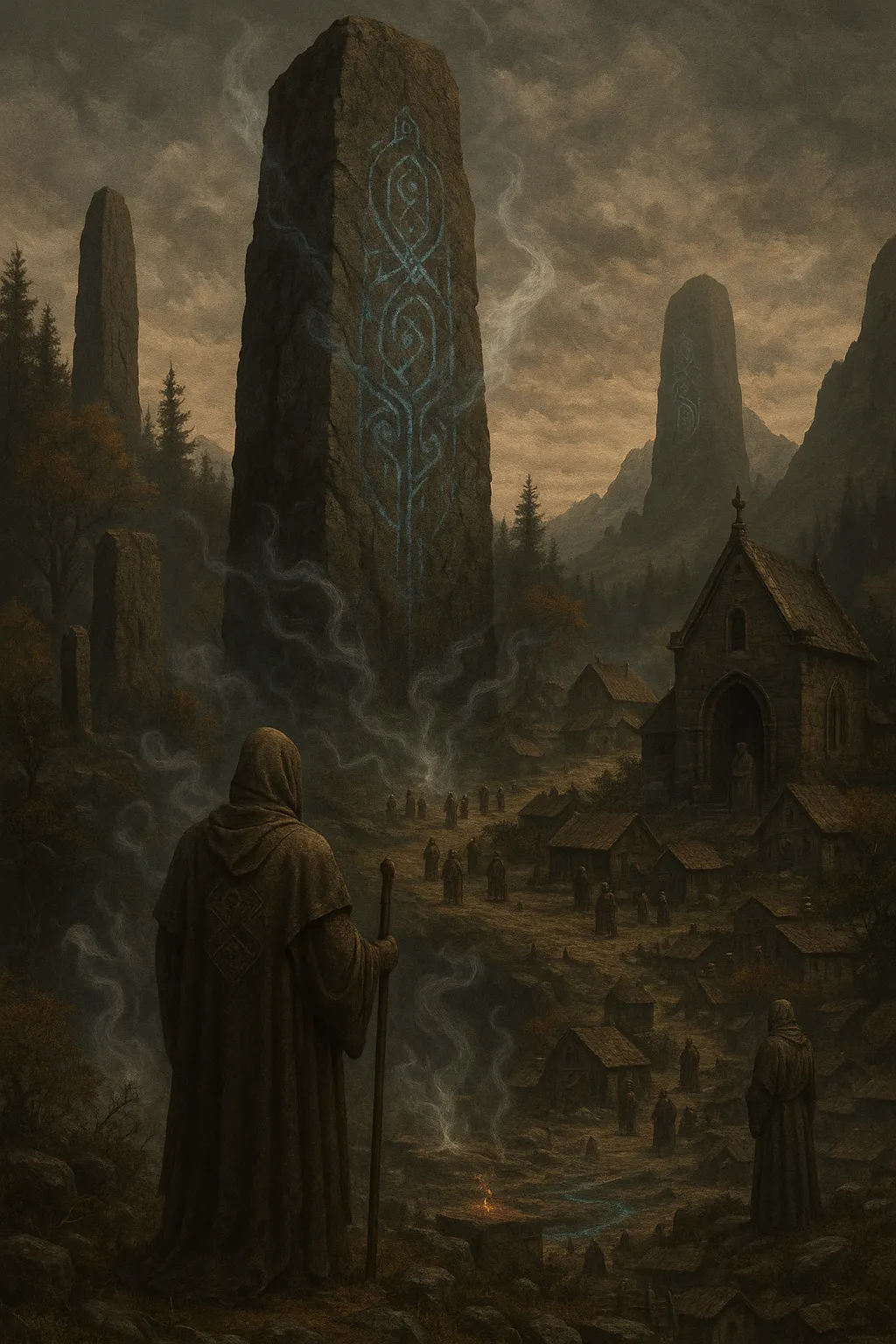
The Keepers of the Seals
The Age of Sacrifice was not only marked by mourning—it was defined by vigilance . From the ashes of war rose new traditions, born of necessity. Across Eminence, Sanctums of the Bound were raised over sites where Naphil had fallen. Some were silent stone towers. Others were hidden groves, glowing with ever-burning runes. These were not temples—they were warnings.
The Keepers of these sanctums—chosen from many peoples—were charged with lives of isolation and spiritual rigor. They bore tattoos of sealing, bled into stone, and chanted old oaths passed down from the rebellion. In their dreams, they sometimes heard whispers—from below.
Even in this solemn age, humanity grew. Settlements became towns, towns became fractured kingdoms. The Halflings formed hidden roads, the Khazadûn reopened a few deep halls, and the Elyndari returned cautiously to the world. Magic, though changed, still moved—but it had rules now, etched into the soul of the land. Some spells required sacrifice. Some could not be cast without scars.
The Naphil were no longer seen—but their legacy shaped every stone laid, every oath sworn. Even peace, in Eminence, came at a price.
Age of Rediscovery: Earth ~1000 - 500BC | Eminence ~3000-1,500 CE
The Light Returns
After a thousand years of vigilance, Eminence began to breathe again. The sanctums still stood. The seals still held. But the world, weary of fear, began to reach outward once more.
Scouts returned to the outer lands. Roads reopened. The
Elyndari emerged from the shrouded groves with cautious hope, seeking the starlit ruins of their lost observatories. The
Khazadûn delved deeper, uncovering vaults untouched since the wars, awakening ancient runes and forgotten forges. The
Halflings , always resilient, rebuilt their hidden networks—merchant roads and safe havens among hills and rivers. Humanity, too, grew bold—cities formed, language evolved, and the spark of curiosity ignited anew.
Magic, once scarred and shunned, flickered back into daily life. Enchanters and loremasters arose. Some sought healing. Others sought power. Many feared it—but more were drawn to it. Forgotten spells were unearthed in broken tablets and scrolls buried beneath generations of stone. The air changed. The skies shimmered again.
It was a time of light, of motion, of rediscovery.
But beneath the surface, the old seals pulsed faintly.
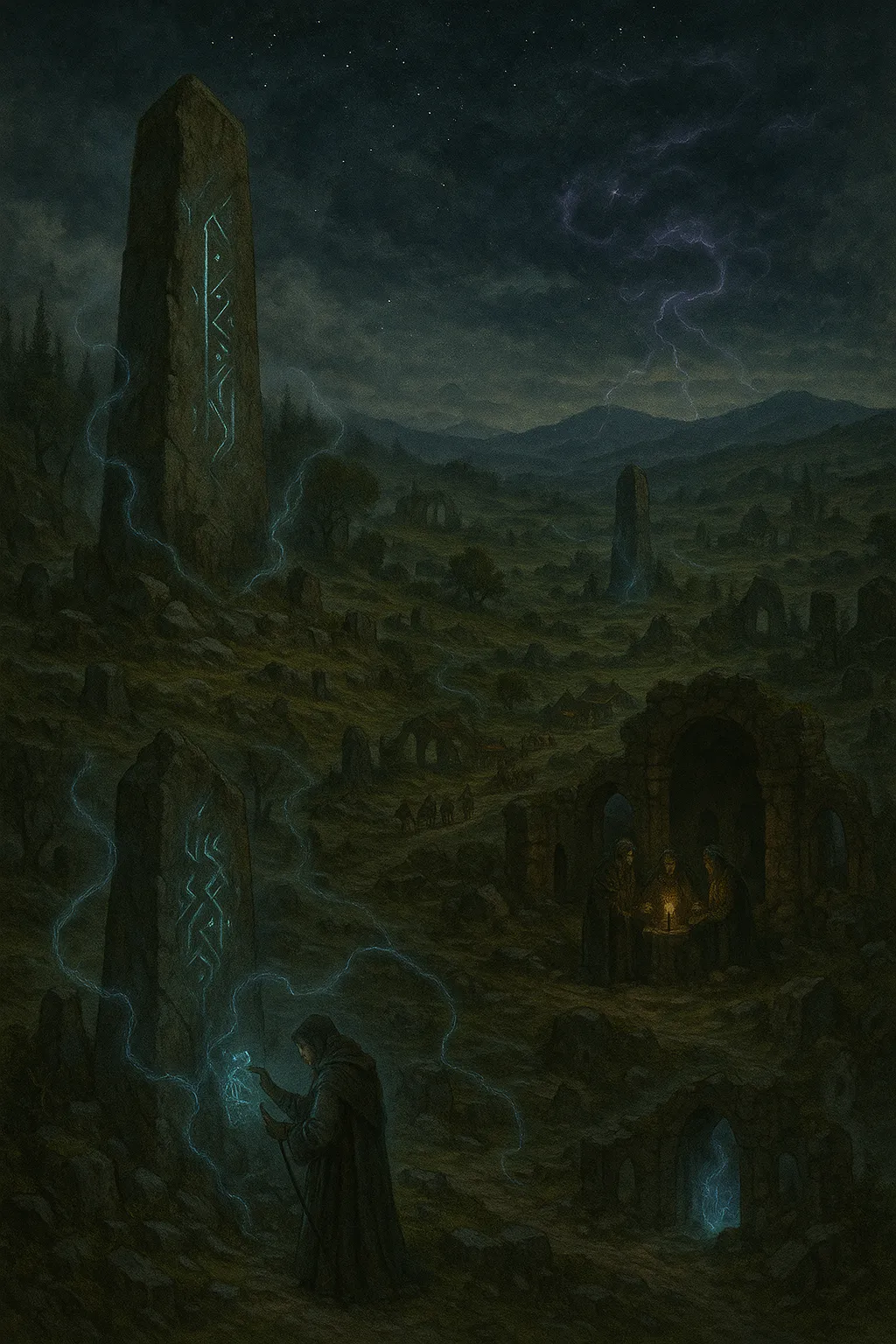
The Stirring Below
Rediscovery brought more than knowledge—it brought
temptation
. As ruins were unearthed and relics studied, ambition returned. And with ambition came danger.
Some guilds formed to protect the balance—
Archivists, Wyrmkeepers, Starseekers—tasked with preserving what had been recovered. Others, like the Duskbinders, dabbled with sealed magics best left untouched. The sanctums, once sacred, became subjects of debate. Could the seals be strengthened? Could the power of the Naphil be controlled? Could knowledge undo fear?
The world no longer hid—but it did not yet understand.
In isolated regions, monoliths began to hum faintly again. Arcane storms struck without warning. Dreams carried strange voices. Prophets walked out of wastelands speaking of a “Second Veil.” And though no Naphil had risen,
their legacy had never truly fallen
. Some believed the age of oppression was returning. Others saw opportunity.
The Age of Rediscovery had opened the world—but it had also opened the door to a deeper, older truth:
That sealing something is not the same as destroying it.
Age of the Guild Wars: Earth ~500BC | Eminence ~1,500 CE
Rise of the Banners
As peace settled into routine, unity gave way to ambition. The old races—Elyndari, Khazadûn, Halflings, and Humans—no longer fought to survive. They fought to control.
The sanctums once guarded in silence became sources of influence. Whoever controlled them, controlled access to ancient magic, forgotten relics, and untapped power. From this pursuit rose the Guilds—factions bound not by blood or nation, but by purpose, belief, or desire.
Some guilds formed to protect: archivists who maintained sacred records, enchanters who sought to restore lost knowledge, defenders who upheld the seals. Others rose from greed or desperation—rogue traders, militant crusaders, and factions willing to gamble with relics best left buried.
Where once the people of Eminence stood together against the Naphil, now they stood across battlefield lines, waving banners not of kingdoms, but of causes. The wars were not always open—but sabotage, assassination, sabotage, and magical arms races tore through cities and wilds alike.
In this age, power became currency, and guild halls became war rooms.
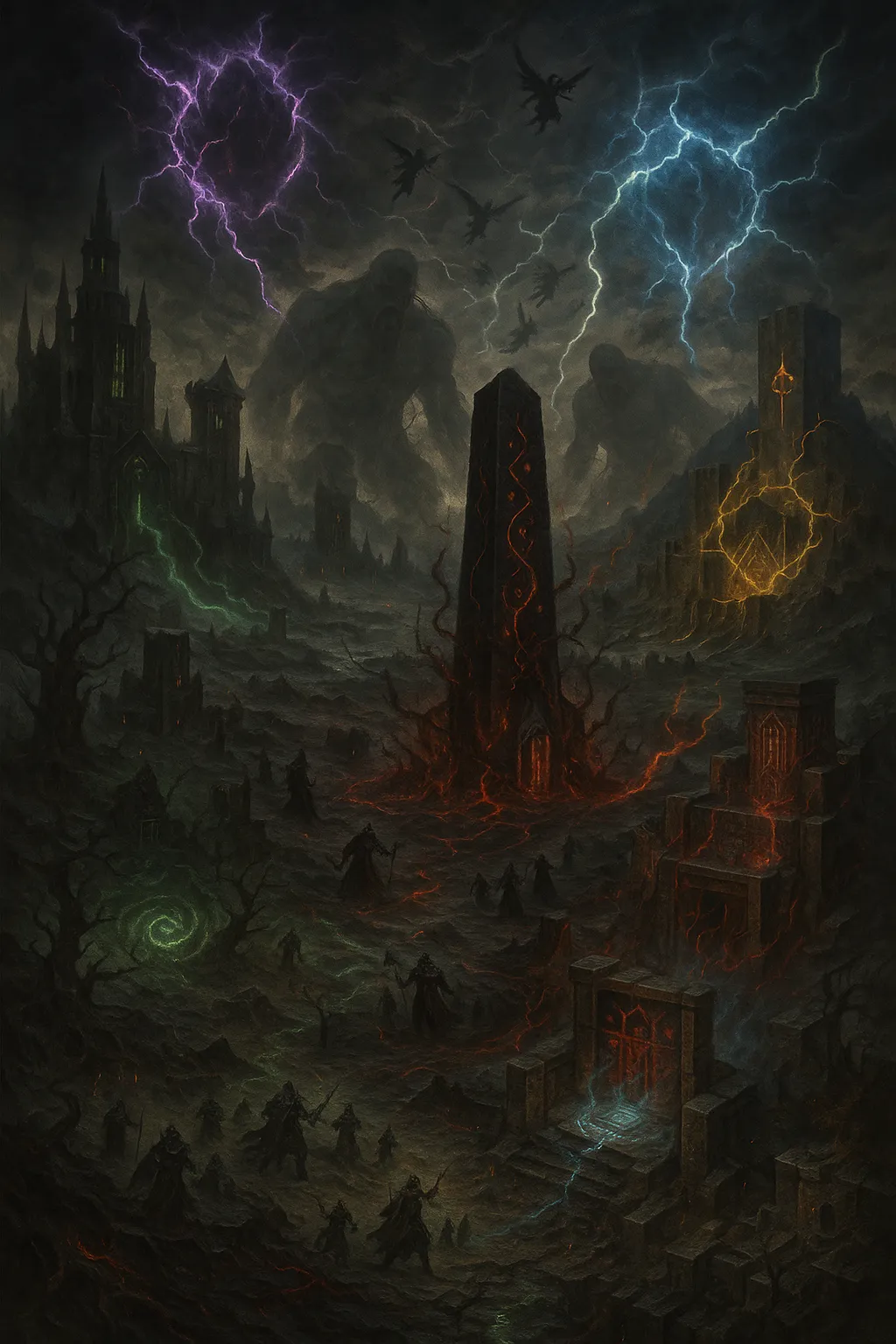
The Fracturing of Purpose
The rise of the guilds marked not just political tension, but a
spiritual fracture in Eminence.
Some factions still revered the Creator and remembered the sacrifice that held the world together. Others believed the old ways were shackles meant to be broken. A few dared to study the very seals meant to contain the Naphil, claiming they could harness the power within.
Conflicts became proxy wars. Sanctums were seized. Magical storms erupted across contested sites. Some guilds tampered with dimensional magic—opening unstable portals or communing with entities beyond the veil. Others forged weapons using shards of corrupted Naphil relics, blurring the line between resistance and heresy.
And yet, not all was lost.
Within the chaos, new heroes rose. Individuals without lineage, chosen not by blood but by conviction. These champions—leaders of guilds or enemies to all—began to reshape the fate of Eminence. For good or for ruin.
By the end of the age, many guilds had fallen. Others solidified power that would last for centuries. But the greatest truth was this:
The Guild Wars weakened the seals.
And the Naphil stirred once more.
Age of Fractures: Earth ~400-300BC | Eminence ~1,200-900 CE
The Shattered Veil
The seals are failing.
No battle announced it, no trumpet sounded—but across Eminence, signs emerged. Sanctums long dormant began to hum with unnatural resonance. Sacred runes lost their glow. Dreams turned to nightmares. And in some places, the veil simply… tore.
One moment, a hillside. The next, a gaping wound in the world—leading to a realm not charted, not named. Portals bled across the land: some leading to broken reflections of Eminence, others to dimensions beyond comprehension. Creatures of twisted magic poured through, not armies, but anomalies —things that should not exist.
The Fractured Veil became more than prophecy—it became reality.
Guilds tried to respond, but few were unified. Many had splintered during the Guild Wars. Others now served hidden forces. Some sought to contain the tears; others studied or even worshiped them. Rumors spread of sealed monoliths cracking
, of ancient beings stirring once more.
And throughout it all, the Naphil whispered louder.
The world was no longer a place of strategy or law. It became a
patchwork of unstable power
, where reality flexed and hope flickered. The fractures were no longer only in the seals—they were in the world itself.
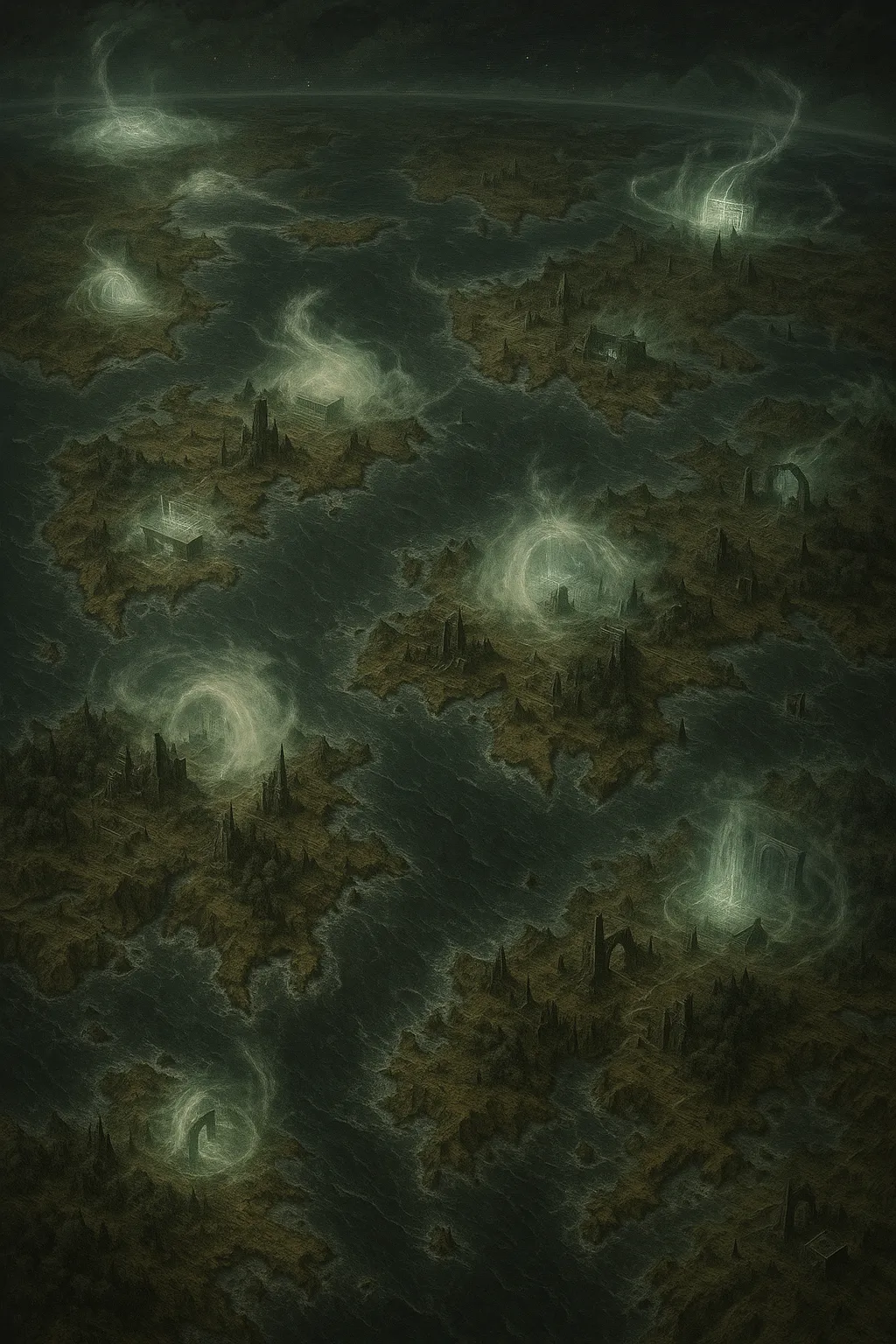
The Quiet War
There is no single warfront now—only a thousand unseen conflicts. Spells cast yesterday may behave differently today. Maps twist. Memories fail. Heroes rise, only to vanish in places that no longer follow the laws of time. And in this chaos, the ambitions of mortals burn hotter than ever.
Some guilds now call themselves Gatekeepers, defending realms from unstable crossings. Others call themselves Heralds
, believing the Naphil’s return is not only inevitable, but destined. Others still wander as fractured orders—trying to seal what little can still be held shut.
The Auralis rarely appear now. When they do, they speak only in riddles and warnings.
Across Eminence, strange phenomena plague the land—rifts opening mid-air, pieces of old cities appearing miles from where they once stood, even portals back to Earth flickering in and out of reality. Some believe the veil is not merely weakening, but rewriting itself.
And yet, in this disorder, there is still hope.
New alliances form in the unlikeliest places. Outcasts become leaders. Power is no longer tied to ancient bloodlines or sealed scrolls—but to those who can endure the madness and still choose to protect what remains.
The Age of Fractures is not an end. It is a reckoning.
While the land of Eminence is vast, our story begins with the Guild Leaders amongst Sylara: High Seer Valtor, Commander Grak, and Maclin "Mac" Oakmoss, respectively.
Grak, with his Iron Legion, sought to expand into Blackwood Forest, seeing it as a resource to be conquered and controlled, gaining renown and fame as to be worthy enough to impress those that would doubt him.
Valtor, the High Seer of Arvandor, Leader of the Sapphire Covenant, sought to protect the ancient magic of the forest without resorting to violence. Yet his knowledge of Rune crafting and historical literacy make him a formidable Leader.
Maclin Oakmoss Leader of the Shadowleaf Syndicate, his home and place of solace Blackwood Forest is being intruded upon and his people are in the crossfire. Mac seeks to protect Blackwood Forest and it's inhabitants from the crosshairs of conquest's destruction, no matter what.
Fame and power shape the future—who will rise, and who will fall?
Join our Discord to take part in the full story
Learn More About the World of Eminence

Quick Links
Home
About
Booking
Shop
Legal
Privacy Policy
Terms & Conditions
©Eminence Games 2025
All Rights Reserved
In the Beginning
“In the beginning God created the heavens and the earth.”
—Genesis 1:1
But the heavens are not one realm, and the story not confined to Earth. At the dawn of all things, the Creator spoke, and from His Word came not just one world, but many—woven with purpose, each fulfilling a part of His greater design. Time, light, and matter sprang forth in divine harmony. Earth was formed for humanity, its soil rich with trial and hope. The stars were hung, the seas contained, and angels—Elohim—were sent to guide creation with wisdom and reverence.
But alongside Earth, He formed Eminence—a realm not fallen, not mundane. A place outside the natural rhythms of Earth, set apart yet aligned. Eminence did not follow the slow arc of entropy, but moved at the pace of purpose. Its skies shimmered with unseen constellations. Its waters carried memory. Its stones held breath. This was no afterthought—it was a realm of preparation, mystery, and wonder. A divine echo, hidden across the veil.
In Heaven, the hosts worshiped. On Earth, mankind would be tested. But Eminence… Eminence was sanctified ground, awaiting its stewards.
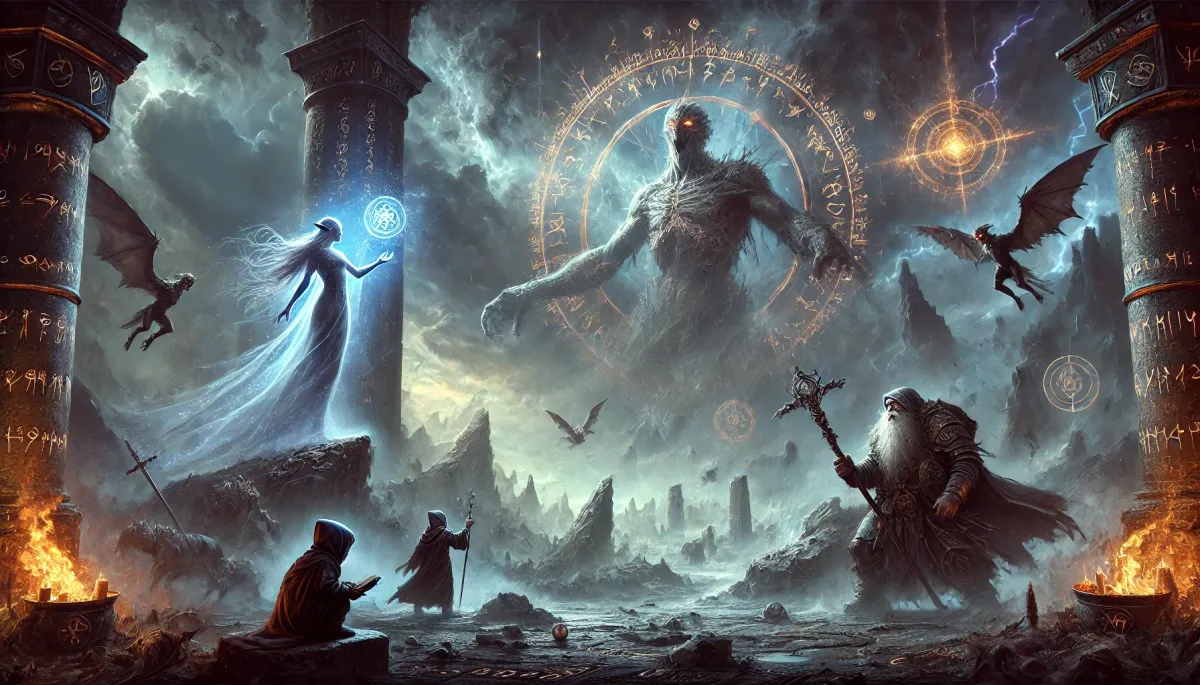
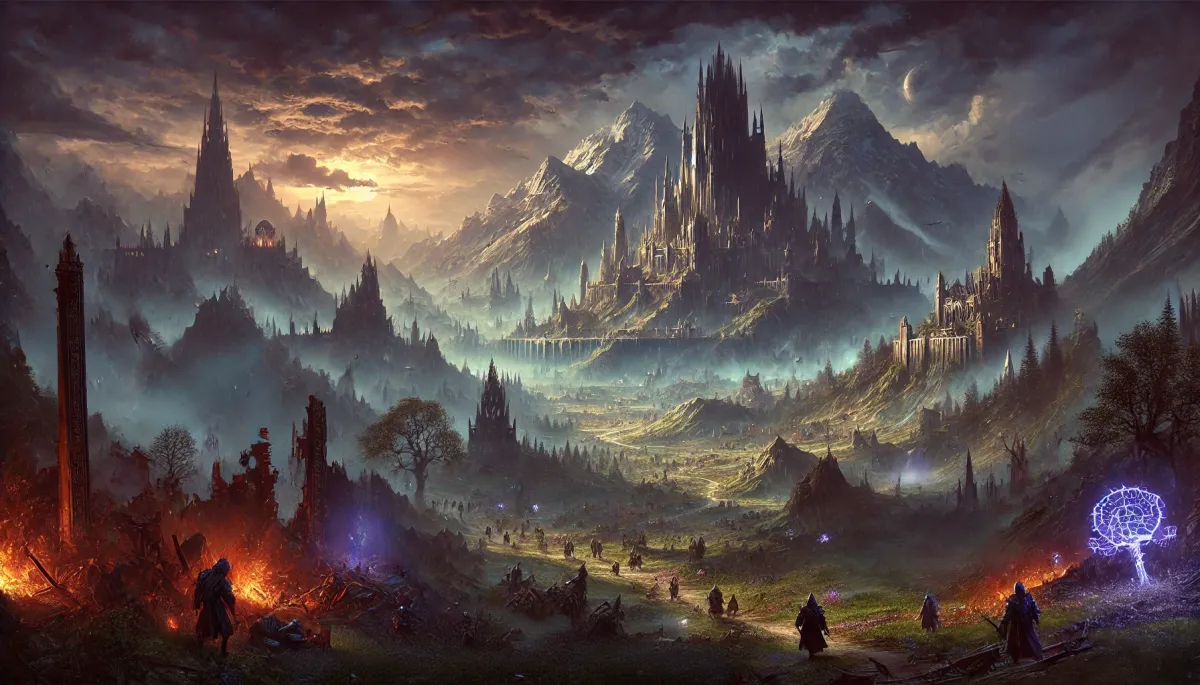
The Shaping of Eminence
Before corruption, before the veil was torn, Eminence stood as a world of divine craftsmanship— a parallel creation , layered with raw magic and sacred order. Formed not from dust, but from intention, it bore the hallmarks of celestial design. The Creator did not populate this realm with humanity, but with three ancient peoples, each embodying an aspect of divine stewardship. The Elyndari, beings of grace and long memory, were tied to wind and forest. They spoke the language of stars, tended living groves, and kept the knowledge of the First Light. The Khazadûn, strong and enduring, emerged from the deep earth. Fire was their ally, stone their scripture. They built with precision and preserved the sacred art of runesmithing. And the Halflings, joyful and clever, filled the hills and valleys, tilling the land and cultivating a life of balance—content with enough, yet vigilant against excess.
These three races lived not in isolation but in harmony, shaping the lands of Eminence with reverence. Magic was not studied—it was breathed, sung, and lived. Their cities echoed with song and silence, invention and instinct. In that age, the world did not war with itself. Every creature and current knew its place in the Creator’s design.
But such harmony cannot last—not when the fall of one realm casts a shadow over the other.